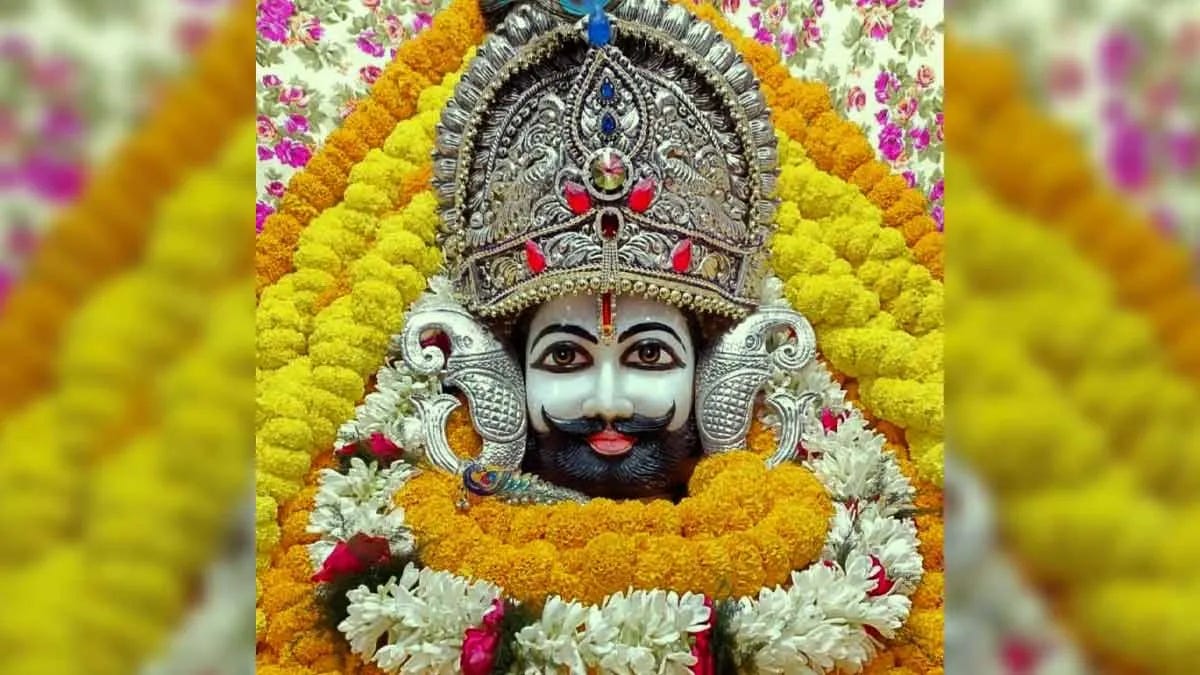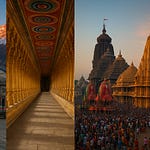The Living Miracle of Faith
In the heart of Rajasthan lies Khatu Shyam Ji Temple, one of India’s most sacred and beloved pilgrimage sites.
Located in the Sikar district, this magnificent temple is dedicated to Shri Khatu Shyam Ji, also known as Barbarika, the grandson of Bhima from the Mahabharata.
For millions of devotees, Khatu Shyam Ji is the “Hare Ka Sahara” - the Supporter of the Defeated.
He represents divine compassion - a deity who listens to every heart, blesses every effort, and gives hope to the hopeless.
Pilgrims from across the world visit this shrine not only to seek blessings but to experience a connection that transcends reason - a faith that heals and transforms.
The Divine Legend of Khatu Shyam Ji
The origin of Khatu Shyam Ji is deeply rooted in the epic of Mahabharata.
Barbarika, the mighty son of Ghatotkacha (and thus Bhima’s grandson), was an unparalleled warrior.
Gifted with three invincible arrows (Teen Baan), he could destroy any army within moments.
However, he had taken an oath to always support the weaker side in battle.
When Lord Krishna tested him before the Kurukshetra war, he realized that Barbarika’s impartial strength would lead to complete annihilation on both sides.
Therefore, Krishna asked for his head as a sacrifice, to prevent imbalance and ensure dharma’s victory.
Barbarika accepted this divine test with humility, offering his head to Krishna in devotion.
Moved by his surrender, Krishna granted him a boon:
“In the Kali Yuga, you shall be worshipped as Shyam, and whoever remembers you with faith shall receive my blessings.”
After the war, Barbarika’s head was placed atop a hill to witness the entire battle.
Later, his head was enshrined in the village of Khatu, where it was miraculously discovered.
In 1027 CE, King Roopsingh Chauhan constructed the first temple after being divinely instructed in a dream to unearth the sacred relic.
From that day onward, Shyam Baba became a living symbol of surrender, humility, and faith.
Spiritual Significance and Beliefs
Devotees call him “Khatu Naresh,” “Lakhdata,” and above all “Hare Ka Sahara.”
It is believed that whoever prays to him sincerely, even once, is blessed with protection and peace.
Khatu Shyam Ji is worshipped not for worldly desires alone but for the inner strength to face life’s challenges.
His teachings remind devotees that victory lies not in power, but in devotion, faith, and surrender.
Every corner of the temple echoes with the chant of
“Shyam Baba Ki Jai”
and “Jako Shyam Bulawe, Vo Khatu Pahuch Jaave.”
(He whom Shyam calls, shall surely reach Khatu.)
The Temple and Its Divine Aura
The temple of Khatu Shyam Ji is built of white marble, adorned with delicate carvings and vibrant Rajasthani motifs.
The sanctum (garbhagriha) houses the idol of Shyam Baba, richly decorated each day with garlands, silver ornaments, and colorful turbans.
Surrounding the main shrine are:
Shyam Kund: The sacred pond where Baba’s head was discovered.
Shyam Bagicha: The temple garden from which flowers for worship are plucked.
Gopinath and Radha-Krishna temples: Companion shrines symbolizing divine love and devotion.
The entire temple complex is filled with fragrance, music, and divine vibrations that comfort every visitor’s heart.
Daily Worship and Aarti Schedule
Every day at Khatu Shyam Ji Temple begins and ends with love, discipline, and devotion.
1. Mangala Aarti (Early Morning)
Performed at dawn to awaken Shyam Baba. Priests sing bhajans as lamps are lit and flowers are offered.
2. Shringar Aarti
The deity is adorned with fresh garlands, silver ornaments, and colorful turbans. Devotees chant while witnessing Baba’s morning beauty.
3. Bhog Aarti (Noon)
The temple priests offer cooked food, fruits, and sweets as bhog. Afterward, this is distributed as prasad.
4. Sandhya Aarti (Evening)
The temple glows with hundreds of diyas, bells ring, and chants fill the air — a time of gratitude and surrender.
5. Shayan Aarti (Night)
Before closing, Shyam Baba is put to rest with lullabies and final prayers. The temple closes for the night in serene silence.
For devotees unable to visit, these aartis are often broadcast live, allowing them to connect with Baba from home.
Home Worship (For Devotees Away from Khatu)
Even at home, devotees can invite Shyam Baba’s blessings through simple rituals:
Keep a clean altar with Shyam Baba’s image or idol.
Offer rose petals, tulsi leaves, and a ghee diya.
Chant “Om Shri Shyam Devaya Namah” or “Om Shyam Sundaraya Namah.”
Recite Khatu Shyam Chalisa or listen to bhajans.
Observe simplicity, fasting, and prayer on Ekadashi or Thursday.
End the puja with gratitude and sharing prasad with family.
Vrats, Sevas, and Donations
Vrat (Fasts):
Many devotees observe fasts on Ekadashi, Dwadashi, or Thursdays.
Fast is usually light - fruits, milk, or simple satvik meals.
The focus is on remembrance and self-discipline rather than austerity.
Seva (Service):
Serving Shyam Baba is a form of worship itself. Devotees perform sevas like:
Donating chadars and flowers.
Organizing bhajan sandhyas and community meals.
Joining the Nishan Yatra, walking barefoot carrying flags to the temple.
Assisting the elderly or volunteering during the Phalgun Mela.
Donations:
Monetary donations support temple upkeep and charity.
Food (Anna Daan) and water distribution are considered highly meritorious.
Donations of blankets, sweets, or clothing to the poor multiply blessings manifold.
Daily Routine of the Temple
The rhythm of daily life in Khatu is devotional from dawn to night:
Before sunrise, priests open the doors for Mangala Darshan.
After morning rituals, devotees offer Chadars, boondi, or peda.
By noon, the temple briefly closes for Bhog Aarti and internal rituals.
In the evening, the Sandhya Aarti draws large gatherings with bhajans.
The night concludes with Shayan Aarti, after which the temple closes.
Every hour spent there feels timeless - the divine fragrance, bells, and chants blending into an ocean of peace.
Festivals and Celebrations
Phalgun Mela
The grandest annual fair in February–March.
Millions walk in the Nishan Yatra, carrying flags as an act of devotion.
Devotees bathe in the Shyam Kund, believed to wash away sins and fulfill wishes.
Bhajan-kirtans, langars, and community sevas fill the town for days.
Ekadashi and Gyaras
Each Ekadashi is marked by fasting, special aartis, and bhajans.
Thousands gather to experience spiritual ecstasy during these days.
Janmashtami, Diwali, and Holi
The temple is decorated with lights and flowers.
Jhankis (tableaux) depicting Lord Krishna and Shyam Baba are displayed.
The energy is vibrant, filled with music and devotion.
Guru Purnima and Kartik Purnima
Devotees honor saints and gurus.
Kartik Purnima is ideal for daan (charity) - lamps, food, and blankets offered in Baba’s name.
Why and When to Visit Khatu Shyam Ji
Best Time to Visit:
October to March - pleasant weather and festive atmosphere.
Phalgun (Feb–Mar) - to witness the grand mela and Nishan Yatra.
Ekadashi Days - for special pujas and aarti.
Why You Should Visit:
To seek refuge in “Hare Ka Sahara.”
To cleanse karmic burdens and restore faith.
To find peace and surrender amidst divine vibrations.
To witness living devotion that unites millions under one name - Shyam.
How to Reach Khatu Shyam Ji
By Air: Jaipur International Airport (80 km).
By Rail: Ringas Junction (17 km).
By Road: Regular buses, taxis, and private vehicles from Jaipur, Delhi, and Sikar.
Well-connected highways and clean roads make the journey comfortable.
Accessibility:
Wheelchair facilities, water counters, and first-aid centers are provided by the temple trust.
For elderly devotees, assistance lines and resting areas are available.
Pilgrim Facilities
Dharamshalas and Guesthouses: Affordable accommodations near the temple.
Langar Halls: Free community kitchens serving thousands daily.
Clean Drinking Water: Available throughout the premises.
Medical Aid: First-aid centers managed by the temple trust.
Bhandaras: Organized frequently, especially during festivals.
Rules and Devotional Etiquette
Remove footwear before entering the temple.
Photography is restricted inside the sanctum.
Maintain silence and queue discipline.
Offer only fresh flowers, sweets, and prasad.
Respect the temple volunteers and priests.
If traveling with elders, plan rest intervals and hydration breaks.
Spiritual Significance and Inner Meaning
Khatu Shyam Ji is more than a deity - he is the embodiment of surrender.
His message is timeless:
“Surrender your ego and trust divine will - for I am with you.”
To visit Khatu is to experience the depth of surrender - a lesson that life’s real victory lies not in strength, but in humility and devotion.
Every prayer uttered here becomes a whisper of hope.
Every tear turns into peace.
And every devotee, no matter how broken, returns healed and whole.
The Essence of ‘Hare Ka Sahara’
The name Hare Ka Sahara encapsulates Baba’s compassion - the belief that even when all doors close, Shyam Baba opens one.
As devotees say:
“When everything ends, Khatu Shyam begins.”
He teaches us that defeat is not failure - it is merely a moment before divine grace.
The Eternal Light of Devotion
Khatu Shyam Ji Temple stands not just as marble and stone, but as a living testimony to faith, surrender, and divine mercy.
Every year, millions arrive in tears and return in peace - proof that Baba listens.
His energy is not limited to the temple; it flows wherever his name is remembered with love.
If you ever feel lost, whisper his name once - “Shyam” - and you will feel a hand guiding you toward strength.
Because for every soul that surrenders in love,
Khatu Shyam Baba is, and will always be, the eternal refuge - the true ‘Hare Ka Sahara.’
खाटू श्याम जी – हारे का सहारा, श्रद्धा का दरबार
Dharmikvibes की ओर से एक भावपूर्ण श्रद्धांजलि
श्रद्धा जेठी भक्ति, भक्ति जेठी श्याम
राजस्थान के सीकर जिले में बसो खाटू धाम, जिथे बसा है भक्तन का आधार, श्री खाटू श्याम जी।
बाबा श्याम, जिनने “हारे का सहारा” कहा जावै, आज करोड़ों मनुष्यों का विश्वास, प्रेरणा और सहारा हैं।
यह मंदिर सिर्फ़ पत्थर का नहीं, परंतु भावना का मंदिर है - जिथे हर मन दुखी भी मुस्कुरावै, हर थक्यो भी राहत पावै।
खाटू श्याम जी की कथा – बर्बरीक से श्याम तक
महाभारत काल में भीम पुत्र घटोत्कच का बेटो बर्बरीक एक अनोखा वीर योद्धा था।
उसके पास तीन बाण (तीन बाण धनुष) थे, जिनसे वह सम्पूर्ण सेना का नाश कर सकतौ था।
उसने वचन दियो कि युद्ध में हमेशा हारन वालो पक्ष का साथ देगौ।
भगवान श्रीकृष्ण जाण गये कि अगर ऐसा हुओ तो पूरा विनाश हो जावे।
कृष्ण ने बर्बरीक से बलिदान मांगे, और उसने अपणो शीश दान कर दियो।
प्रसन्न होकर श्रीकृष्ण बोले –
“कलियुग में तू ‘श्याम’ नाम से पूज्य होएगो। जो मनुष्य तेरा नाम लेवेगो, मैं उसे वरदान दूँगो।”
महाभारत के युद्ध के बाद बर्बरीक का सिर खाटू नगरी में धरती भीतर मिल्यो।
फिर एक दिन राजा रूपसिंह चौहान ने स्वप्न में देख्यो कि खाटू में यह पवित्र शीश गाड़्यो है।
उन्होंने सन् 1027 ई. में मंदिर बनवायो - और तभी से खाटू श्याम बाबा भक्तों का हारे का सहारा बन गया।
आध्यात्मिक महत्व – हारे का सहारा, सबका प्यारा
श्याम बाबा को कहा जावै –
“खाटू नरेश, लाखदाता, हारे का सहारा।”
भक्त मानते हैं कि जब जीवन में हार मिलै, रास्ता सूझै नहीं, तब श्याम नाम लेतैं ही चमत्कार होतौ है।
यहाँ की वायु में विश्वास घुल्यो है, हर श्वास में नाम है – “श्याम बाबा की जय”।
कहा जावै –
“जाको श्याम बुलावे, वो खाटू जरूर पधारे।”
खाटू धाम का मंदिर और उसकी भव्यता
संगमरमर से बने मंदिर में श्याम बाबा का दरबार अत्यंत सुंदर है।
दीवारों पर राजस्थानी नक्काशी, रंगीन झूमर, और चांदी के फाटक - सब भक्त को अद्भुत शांति देतैं।
मंदिर परिसर में मुख्य स्थान हैं –
श्याम कुंड: जिथे बाबा का शीश प्रकट हुआ।
श्याम बगीचा: जिथे से पूजा के फूल तोड़े जावै।
गोपीनाथ व राधा-कृष्ण मंदिर: प्रेम और भक्ति का प्रतीक।
खाटू श्याम जी की दैनिक आरती और पूजा क्रम
मंगल आरती (भोर):
भोर होते ही मंदिर खुलै, घंटियां बजै, गुलाब की खुशबू छावै। पुजारी बाबा को जगावे हैं।
श्रृंगार आरती:
बाबा को नए वस्त्र, फूलों और आभूषणों से सजायो जावै। भक्त श्रृंगार दर्शन करतैं हैं।
भोग आरती (दोपहर):
भोग में दूध, खीर, मेवा, फल और मिठाई अर्पित की जावै।
संध्या आरती:
शाम होते ही मंदिर दीपों से झिलमिल कर उठै। भजन गूंजतैं हैं - “श्याम नाम की माला जपो।”
शयन आरती:
रात में बाबा को विश्राम करायो जावै, और मंदिर में शांति छा जावै।
घर पर पूजा की विधि
जिन भक्तों को खाटू ना जावै बने, वो घर में ही बाबा की पूजा कर सकतैं:
स्वच्छ जगह पर बाबा की तस्वीर या मूर्ति रखो।
दीप जलाओ, फूल, तुलसी और गुलाब अर्पित करो।
मंत्र बोलो: “ॐ श्री श्याम देवाय नमः” या “ॐ श्याम सुंदराय नमः।”
श्याम चालीसा या भजन सुनो।
प्रसाद में फल या मिठाई चढ़ाओ और परिवार में बांटो।
व्रत, सेवा और दान का महत्व
व्रत (उपवास):
गुरुवार या एकादशी को व्रत रखो।
फलाहार या दूध का सेवन करो।
दिनभर नामस्मरण और मनन करो।
सेवा (सेवा भाव):
चादर, फूल या प्रसाद चढ़ाओ।
भजन संध्या आयोजित करो।
“निशान यात्रा” में पैदल झंडा लेकर खाटू पहुँचो।
मेले में सेवा करो — जल वितरण, भोजन वितरण आदि।
दान:
मंदिर में धन दान या अन्नदान करो।
गरीबों को कपड़े, कंबल, और भोजन दो।
ये सब बाबा की कृपा के रूप में कई गुना फल देते हैं।
मंदिर की दैनिक दिनचर्या
सुबह 4:30 बजे से मंदिर खुल जावै, बाबा के दर्शन शुरू हो जावै।
दोपहर में मंदिर कुछ समय बंद रहै, फिर शाम को संध्या आरती होवै।
रात को शयन आरती के बाद मंदिर बंद कर देतैं।
मंदिर का हर क्षण भक्ति और संगीत से गूंजतौ है।
खाटू के मेले और उत्सव
फाल्गुन मेला:
फरवरी–मार्च में लगै, लाखों भक्त पैदल निशान यात्रा लेकर पहुँचतैं।
श्याम कुंड में स्नान करनै से पाप मिटतैं, मनोकामना पूर्ण होतैं।
भजन, कीर्तन, लंगर, सेवा का माहौल सैकड़ों किलोमीटर तक फैल जातौ है।
एकादशी और ग्यारस:
हर एकादशी पर विशेष आरती, उपवास और भजन होते हैं।
दीवाली, जन्माष्टमी, होली:
मंदिर रोशनी और फूलों से सजै, झांकियाँ और भजन कार्यक्रम चलते हैं।
गुरु पूर्णिमा और कार्तिक पूर्णिमा:
संतों और गुरुओं की पूजा, दान-पुण्य और दीपदान का महत्व।
कब और क्यों जाएँ
कब जाएँ:
अक्टूबर से मार्च तक का समय सबसे उचित।
फाल्गुन मेले में बाबा की कृपा का विशेष अनुभव।
क्यों जाएँ:
बाबा श्याम “हारे का सहारा” हैं - जब कोई साथ ना दे, तब वे जरूर देते हैं।
यहाँ जाने से मन को शांति, आत्मा को संतोष और जीवन में नई दिशा मिलती है।
कैसे पहुँचें खाटू धाम
हवाई मार्ग: जयपुर एयरपोर्ट (लगभग 80 किमी)।
रेल मार्ग: रींगस जंक्शन (17 किमी)।
सड़क मार्ग: जयपुर, सीकर, दिल्ली से नियमित बसें और टैक्सी उपलब्ध।
सुविधाएँ:
वृद्ध या दिव्यांग भक्तों के लिए व्हीलचेयर व सहायता केंद्र।
धर्मशालाएँ, भोजनशालाएँ और बाणगाँव लंगर सब सुविधा-युक्त हैं।
खाटू धाम में भक्तों के लिए नियम
मंदिर में प्रवेश से पहले जूते-चप्पल बाहर उतारें।
फोटो और मोबाइल का उपयोग गर्भगृह में वर्जित है।
साफ फूल, प्रसाद और वस्त्र ही अर्पित करें।
शांति और अनुशासन बनाए रखें।
खाटू धाम का दर्शन – श्रद्धा का अनुभव
खाटू पहुँचना मात्र यात्रा नहीं, अनुभव है।
यहाँ की हवा में गुलाब की महक है, घंटियों की गूँज है, और हर कोने में “श्याम नाम” का भाव।
भक्त कहते हैं -
“जब कुछ ना बचे, तब श्याम ही सहारा बने।”
यह स्थान सिखावै है कि हार में भी आशा है, और समर्पण में ही विजय है।
खाटू श्याम जी का संदेश
“अभिमान छोड़ो, विश्वास रखो, और कर्म करो - मैं साथ हूँ।”
बाबा श्याम हमें सिखाते हैं कि जीत हमेशा शक्ति से नहीं, भक्ति से होती है।
उनका दरबार हर टूटे हुए दिल को जोड़ देता है, हर थके मन को संबल देतौ है।
हारे का सहारा, सच्ची भक्ति का आधार
खाटू श्याम जी का मंदिर केवल पूजा का स्थल नहीं,
यह समर्पण, करुणा और विश्वास का जीवंत प्रतीक है।
हर साल लाखों लोग यहाँ आकर मन की बात कहते हैं - और लौटते समय बोझ हल्का हो जातौ है।
क्योंकि बाबा श्याम सबकी सुनते हैं, सबको अपनाते हैं।
और जैसा कहा जावै -
“जाको श्याम बुलावे, वो खाटू जरूर आवे।”
जो दिल से पुकारे, बाबा जरूर सुनतैं हैं।
खाटू धाम वही जगह है जहाँ हार नहीं, बस प्रेम, भक्ति और शांति है।












